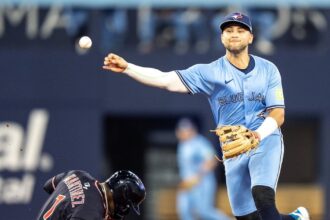The Toronto Blue Jays clinched the American League East title last night with a commanding 13-4 victory over the Tampa Bay Rays, unleashing a celebration that was years in the making. As the final out settled into George Springer’s glove in right field, the Rogers Centre erupted in a deafening roar that seemed to release all the pent-up expectations of a fanbase that has weathered its share of disappointments.
This wasn’t just a win; it was a statement. The Blue Jays dismantled the Rays with the kind of offensive firepower that has defined their season – a balanced attack where contributions came from throughout the lineup. Vladimir Guerrero Jr. continued his MVP-caliber season with a three-run homer that nearly reached the fifth deck, while Bo Bichette added four hits of his own in a performance that reminded everyone why this team has been considered a sleeping giant in the East.
What makes this division title particularly sweet is the journey that preceded it. The Blue Jays have spent years assembling this roster, weathering criticisms about whether their young core could ever translate potential into results. The front office’s patience has finally paid dividends in a way that validates their long-term vision for the franchise.
“This team has something special that you can’t measure with stats,” manager John Schneider told reporters in the champagne-soaked clubhouse. “There’s a resilience here that carried us through the tough stretches earlier this season when everyone was ready to write us off.”
Indeed, back in May when the Blue Jays were hovering around .500, the CO24 Opinions section was filled with analyses questioning whether this group had the mental fortitude to compete with the Yankees and Rays. What followed was a remarkable three-month surge that saw them go 57-29 after the All-Star break.
The transformation of this team mirrors a broader shift in Toronto’s sports culture. For a city that has experienced its share of sports heartbreaks, the Blue Jays’ success represents more than just baseball excellence – it’s become a unifying cultural moment. The scenes outside the Rogers Centre last night, with thousands of fans spilling onto Front Street in celebration, reflected how deeply this team has embedded itself in the city’s identity.
Perhaps most impressively, the Blue Jays accomplished this in a division that features perennial powerhouses in the Yankees and the analytically savvy Rays. Their path to the division crown required them to overcome not just talented opponents, but the weight of expectations that has crushed previous iterations of the team.
The current trend in Major League Baseball has been toward teams that can combine power hitting with advanced analytics, and the Blue Jays have mastered this balance. Their pitching staff, led by Kevin Gausman and Chris Bassitt, has embraced modern approaches to sequencing and pitch design, while their lineup has maintained the explosive potential that makes them must-see television.
As the Blue Jays prepare for the postseason, questions remain about whether they can translate this regular season success into October glory. The franchise hasn’t won a World Series since their back-to-back titles in 1992 and 1993, and an entire generation of fans has grown up knowing only playoff disappointments or missed opportunities.
But for now, Toronto basks in the glow of achievement. The AL East title represents validation for a process that required faith during difficult times. As the celebration continues and attention turns to playoff matchups, one thing is certain: baseball in Toronto matters again, not just as a pastime, but as a central element of the city’s cultural conversation.
Will this be the year the Blue Jays finally translate their immense talent into a championship? The beauty of baseball in October is that the answer lies in the unwritten pages ahead.










